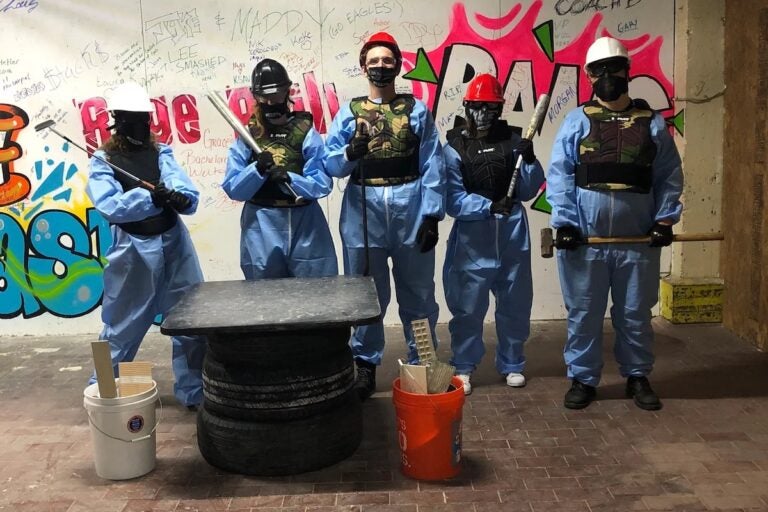Rage rooms invite people to ‘engage’ with their anger, but do they actually work?
‘Rage’ rooms have become a popular catharsis for people desperate to release pent up anger, but some psychologists are cautious about the hype.
Listen 8:42
Rage Room Philly is a recreation center where customers can pay to deal with their anger, by smashing objects. (Billy Penn)
This story is from The Pulse, a weekly health and science podcast.
Find it on Apple Podcasts, Spotify, or wherever you get your podcasts.
In 2018, Kea Tull noticed that her daughter was struggling at college. She had just failed an exam, twice.
“At night she came home and she was like, ‘I just want to pay to break something,’” Tull recalled. “And I’m looking at her like, ‘You gotta be kidding me? Who pays to break something?’”
Desperate to help her daughter, she searched the internet to find some answers. Almost immediately, dozens of searches popped up for something called “rage rooms.”
These places took abandoned warehouses and vacant offices and turned them into businesses made for organized chaos. Some were also marketed as an “alternative” to anger management.
Tull was looking at images of people smashing glassware, electronics and vintage furniture – with sledge hammers and baseball bats.
It seemed like a perfect fit for her daughter, but there was one problem – their hometown, Philadelphia, didn’t have one. So Tull decided to ask her daughter if she’d start a business with her.
“‘Would you want to be your own boss?,’” Tull asked her daughter. “And she said ‘yeah.’ I’m like, we gotta look into this. It really piqued my interest. I couldn’t sleep at night. It was on my mind so much that I just started looking into doing it.”
Five years later, Tull and her daughter Nyerema Jordan are the co-owners of Rage Room Philadelphia. Their tagline – “A place where you can Fu#% some Sh!t up and have a ball doing it!!!”
Subscribe to The Pulse
At Rage Room Philadelphia, for fees ranging from $30 to $100, prospective “ragers,” as Tull calls them, have plenty of options to grab a baseball bat, crowbar or sledgehammer, and smash their anger away.
There’s the basic 5 minute Fast n Furious package, which for $30 includes one bucket of breakables – from kids toys, small electronics and bottles – for five minutes of rage time. Or there’s a one-hour car smash session for groups of up to 12 people.
And yes – most people are successful at destroying an entire vehicle in that time, said Johnson.
“They rip out the seats. They rip out the doors,” she said. “They rip off the trunk. They rip off the hood. They tear off the steering wheel. It’s gotten to the point where the tow truck driver that we work with said don’t take off the steering wheel, and we have been pretty good with it so far.”
From 9 a.m. to 5 p.m., Tull works as an administrative coordinator at Philadelphia College of Osteopathic Medicine. At night, she becomes every rager’s hype person. With a microphone and loudspeaker, she animates and rallies behind each person swinging and hacking through their time.
“They get in there and I would say every bit of 10 minutes, 13 minutes, they’re like huffing and puffing and they’re trying to give up and I’m encouraging them in my own happy way to complete it,” she said.
Rage Room Philadelphia draws a diverse crowd. From birthdays, holiday celebrations and bachelorette parties. There are also people who signed up because they experienced a bad breakup, have repressed trauma or stressful jobs.
“We allow our customers … to write on a wall at the end,” Tull said. “They can put their autograph on a wall – write whatever they feel – and everybody will zoom in and say,
‘I see that right there. They had to have been a teacher!’”
For Andrew Powers, CEO of Break Stuff N.J. in New Brunswick, New Jersey, teachers are among his most loyal customers.
“We give discounts for all teachers and mental health professionals, or first responders,” he said. “Teachers take advantage of that quite frequently and we love having them.”
Like Rage Room Philadelphia, Break Stuff N.J. caters its business to different things. Customers are often serious about using a rage room as a cathartic form of therapy.
“We’ve had people who’ve lost their children, who’ve lost their spouses, who’ve lost their jobs right before Christmas, and it’s just there’s a lot of heartbreak that walks into the door,” he said.
But for Powers, rage rooms shouldn’t be a place to release anger.
Instead one customer told him, “‘No, no, I’m not releasing my anger. I’m engaging with my anger. This is a safe space where I can play with it where I can understand it.’”
In 2008, rage rooms were largely unseen by the rest of the world. But during the Great Recession, a business called The Venting Place became the first known rage room for stressed workers in Tokyo, Japan. Since then, hundreds more have opened around the world, including in the U.S.
In some instances, rage rooms have been touted by owners as ‘smash room therapy’ – or a substitute to anger management therapy. It’s caused some clinical psychologists, like Patrick Markey, a professor of psychology and brain sciences at Villanova University in Philadelphia, to raise questions about this growing trend.
“I’d be a little apprehensive about it being used as a straight therapeutic technique, simply because if somebody has rage issues, you want to make sure whatever you’re doing is probably effective at reducing their rage issues and not either counterproductive or not doing anything at all,” Markey said.
For clinical psychologist and neuroscientist at Temple University, Michael McCloskey, people with disorders such as intermittent explosive disorder, a long-term, neurological condition characterized by bouts of rage, irritability, physical attacks and self-harm, should steer clear of such activities.
“I use the metaphor of a car,” McCloskey said. “Imagine you have a car. One of those cars, where the minute you tap on the gas, it goes. And then imagine the brakes don’t work very well, you’re gonna probably get in some crashes.”
But like video games, exercise or ax throwing, McCloskey argues that rage rooms are just another activity that when done in a safe manner can help people step away from their stress.
“Smashing something can be fun, especially when you know it’s okay,” he said. Aggression is — usually when we think about it — you’re hurting something or someone who does not want that to happen. Here, it’s like…perfectly fine. Go ahead, knock yourself out,’” he said.
WHYY is your source for fact-based, in-depth journalism and information. As a nonprofit organization, we rely on financial support from readers like you. Please give today.







